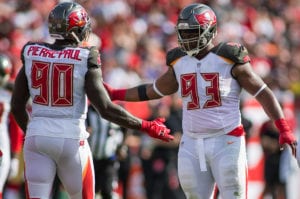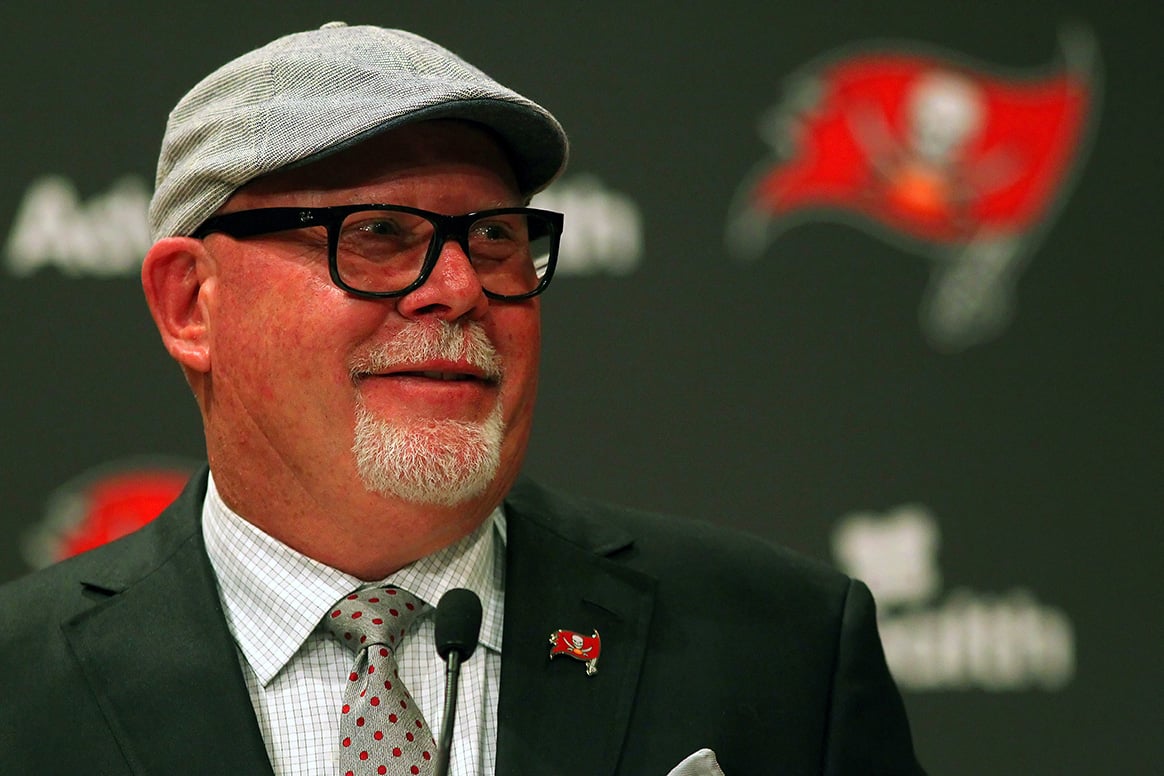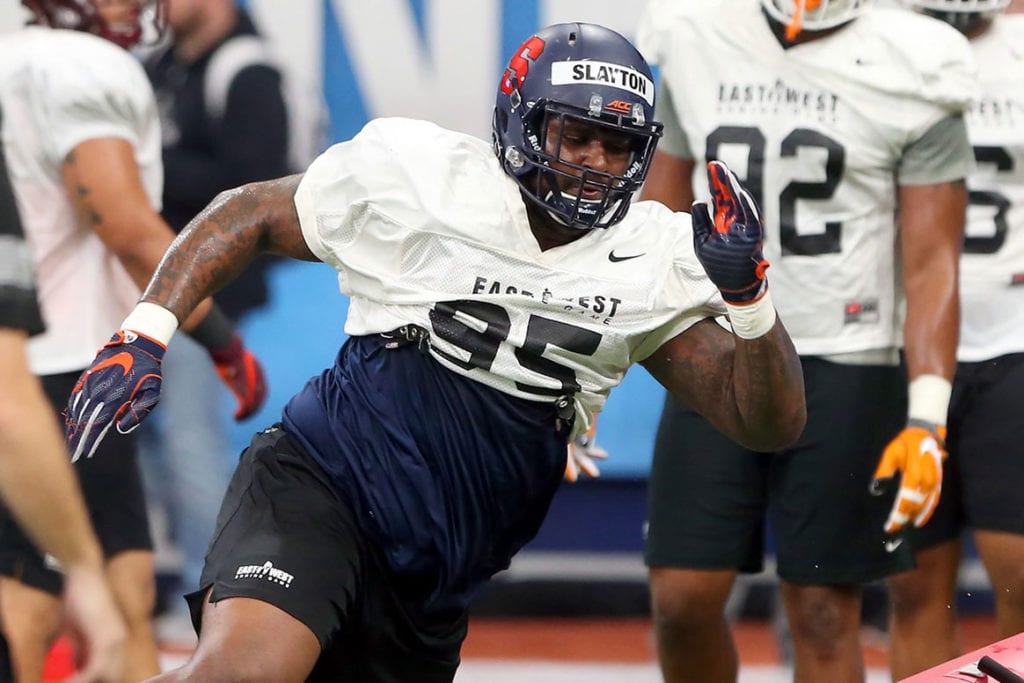All-Twenty Tuesday: Bowles’ Bucs Defense
Oh, man. I’ve been waiting to write this part of the Cover 3 for about two weeks now, ever since Buccaneers new defensive coordinator Todd Bowles came onto the radar during the coaching search.
For the past two years, Bucs fans have been enamored with defensive fronts in base scheme. The Bucs have been a 4-3 base team for a long time. Not that they haven’t switched up their defensive alignments here and there during games, but their philosophy has been built around what you would say is a 4-3 for a while.
As the defensive output has been downright terrible over the last few years, it has allowed fans to question the base philosophy and request/imagine a change from a 4-3 to a 3-4. The Bucs have the personnel to play either scheme, as Scott Reynolds wrote in his latest SR’s Fab 5.
Here’s the secret: in the best defenses, the base scheme doesn’t really matter – and the Buccaneers certainly were not one of the best defenses, that’s why most fans don’t know that as well as they should.
Shown above we have the two vanilla versions of what you would call 4-3 and 3-4 defenses. The numbers signify a seven-man front, which is the most common in football when it comes to defense. Why? Because base defense is designed to stop the run, which is where most defensive philosophies were based around (hence the name) for most of football’s history up until now.
With five offensive linemen, a tight end/fullback and running back, you want to make sure you have each gap or blocker accounted for and matched while leaving one player free to tackle the ball carrier. The defense always needs to have one more player than the offense does blockers in order to make a stop, and that’s why base defense contains seven total players.
In a 4-3, you have four down linemen, which means four players on the line of scrimmage with their hand in the ground in a 3-point or 2-point stance with three linebackers behind them. In a a 3-4, you have just three down linemen (hence what the numbers mean) and four linebackers behind them. But no matter where you position them, the number is still seven.
So then what’s the difference? There are many preferences, styles and tweaks that make each defense unique, but the main difference between a 4-3 and a 3-4 is what you ask of your defensive linemen. In a 4-3, with more defensive linemen on the line of scrimmage and closer to the ball, you traditionally ask them to “one gap,” meaning they are responsible for just the A gap (between the center and the guard) or just the B (between the guard and the offensive tackle) gap or just the C gap (on the outside of the offensive tackle in contain). This allows the defensive linemen to shoot through gaps past blockers and make plays in the backfield themselves because they don’t have to hesitate.
In a 3-4, defensive linemen are much more traditionally asked to “two gap,” meaning that with less defensive linemen on the line of scrimmage, you want them responsible for two gaps instead of one. In a 4-3, since linemen are responsible for just one gap, you usually place them right in between or right off the shoulder of one of the offensive linemen (shading) so they can shoot through the open space. In a two-gap system, you see the defensive linemen all head-up, straight in front of an offensive linemen so they can move either to their left or right while watching both gaps in order to stop the run.

Bucs DE Jason Pierre-Paul and DT Gerald McCoy – Photo by: Mary Holt/PR
Now, which philosophy should you choose and why? That depends on your players. If your best players are along the defensive line, in most cases you’ll want them to have less overall responsibilities when it comes to hesitation and you’ll want them to just have one train of thought: explode, beat your assignment, shoot through your gap and make a play. If your best players are your linebackers, you want your defensive linemen to take up as many gaps or blocks as possible to leave your linebackers free to make tackles on the ball carrier or sacks in the passing game.
No matter what, though, in order to be effective, your defense has to be built around being aggressive to make stops. That is where the Buccaneers failed under Mike Smith. Under Smith, the Bucs emphasized their linebackers, but decided to play only three of them in a 4-3. Smith wasted talents like Gerald McCoy, asking him to just take up blocks instead of getting to the quarterback. Though they didn’t technically two gap in their 4-3 system, defensive linemen were being told to stay on their blocks to keep the linebackers free – that mean less numbers and less effectiveness, a double negative.
It was stupid. It was backwards. It was scared. It didn’t work.
In comes Bowles, who is much more likely to deploy a defensive system that will fit what the players, whoever that may be, do best – you just hope it’s not too late for some of their talented older guys.
People just assumed that Bowles is going to move the Buccaneers to a 3-4 defense because that’s what he was in Arizona with Arians and when he was the head coach of the Jets, but even Bowles himself said that he’s spent half of his career in a 4-3 and half in a 3-4, the 3-4 just happened to be what he coached in his last two stops because that’s what was best with the personnel they had.
When Bowles took over for Ray Horton in Arizona in 2013, there was some uncertainty to how effective he would be.
The answer: very. Why? Just listen to his players.

Bucs DC Todd Bowles – Photo by: Getty Images
“It’s like a million pounds off your shoulders,” Three-time Pro Bowler Darnell Dockett said. “Personally, I had nothing against Ray. But I hated that scheme. I really hated it. I played it because I needed to. But this defense is based on guys and what their ability allows them to be good at – what they were drafted for.”
Under Horton, guys like Dockett and Calais Campbell were asked to just hold their blocks and let players from the second and third levels be the ones to make the plays. It’s such a lame way to play defense. If you have talented defensive linemen who can get off blocks, why would you not want the guys closest to the ball be the ones to make the play?
You know why football starts up front? Because the closer you are to the ball, the bigger/faster impact you can have on it as a defense. If you have the defensive line to make plays, always, always, always base your play-making around them. That is the highest ceiling of defensive impact.
“Darnell and myself, I feel like we have the ability to make a lot of different plays, but sometimes in the 3-4 you have to put the team in front of yourself,” Calais Campbell said. “This defense, the way we are doing things, it gives us a chance to make a difference.”
Even after Campbell left Arizona, he said one thing he was thankful for in Jacksonville was for a defense that allowed him to be aggressive and go make plays. That’s what he had under Bowles in his two years as defensive coordinator in Arizona. The Cardinals were a 3-4 team – but played an aggressive, one-gap scheme. They didn’t two-gap their defensive linemen there and won’t be doing that in Tampa Bay, either.
And that’s the key word: aggressive. No matter what the Bucs end up deploying when it comes to base defense – the league plays almost 70 percent in nickel defense anyways – it is going to be aggressive.
“I would argue that Bowles is even more creative with his pressures than Horton,” Greg Cosell said. Horton, while he was very good, was out of that Dick LeBeau/Dom Capers school. Not that it’s not creative, but there are certain blitz concepts that all those guys use. Bowles is great with triple A-gap pressure, and that’s almost impossible to pick up.”
http://www.giphy.com/gifs/5eFueq1OyWpLjAJs2s
First down, second down, third down, it doesn’t matter, Bowles is going to put the pressure on you. He’s going to make sure that, at the end of the day, the only way they’re going to lose that game is if they can tip their hat to the quarterback and say, “That was just a damn good performance.”
If a quarterback cannot adapt to pressure, both in the pre-snap and during the play, Bowles’ defense will eat them alive. He does this by pairing exotic pressure looks with tight coverage on the back end.
http://www.giphy.com/gifs/kEoZi0oVwusPy2VEmi
The two GIFs above are different angles of the same play. In the first view, you can see how confusing the pressure was to pick up, with added defenders crashing the pocket along with different stunts and twists from the outside up the middle. In the second view, you see what coverage it was paired with on the back end.
Press and pressure will likely be the name of the game with Bowles.
http://www.giphy.com/gifs/1xnu5tR4mjE9roYBDM
A common theme in a lot of the Bowles’ film I watched, both with the Jets and with the Cardinals, is that he has his linebackers try to confuse quarterbacks as best they can in the pre-snap.
Look at all the walking around the linebackers did before the snap. That must have been very confusing for both the quarterback and the offensive line, and the only way a blitz like that gets picked up is if you’re dealing with a unit that has tip-top chemistry. If they don’t, the result like the one above can occur.
http://www.giphy.com/gifs/1yivgU0NOIZzf8zTtQ
I’m using this last clip as an example to show you that, just because a player may be aligned in a spot where you don’t normally attack – 0-tech and 4-tech linemen usually just take up blocks – Bowles tells his guys that no matter where they are, they have the freedom to make a play if they’re in position to. In the play above, his nose tackle certainly did, and there was no hesitation to get off the block and get the sack. That’s the true definition of being aggressive at every level and every position.
So, as you can see, it doesn’t really matter what they call it. The Bucs will play in 3-4, 3-4 Under, 4-3, 4-3 Under, 4-3 Over, 3-3-5 – all that jazz. And the reason why they’re going to be that multiple is because no matter how they’re aligned, the goal is the same.
Attack.
Trevor Sikkema is the Tampa Bay Buccaneers beat reporter and NFL Draft analyst for PewterReport.com. Sikkema, an alumnus of the University of Florida, has covered both college and professional football for much of his career. As a native of the Sunshine State, when he's not buried in social media, Sikkema can be found out and active, attempting to be the best athlete he never was. Sikkema can be reached at: [email protected]





